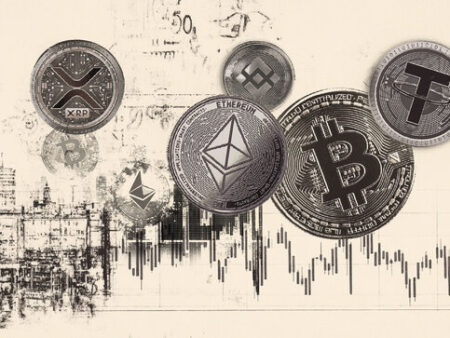Bitcoin’s July Surge: A Sign of Market Maturity?
July proved to be a significant month for Bitcoin, reinforcing the notion that the current bull cycle is maturing. The period was marked by regulatory advancements and increased participation from institutional investors in the cryptocurrency market.
“July’s performance reinforces the idea that we are in a mature phase of the current bull cycle,” says Ana de Mattos, Technical Analyst and Trading Partner at Ripio.
The approval of the GENIUS Act brought stablecoins under a new legal framework in the U.S., while Bitcoin reached new all-time highs, acting as a catalyst for rallies in other cryptocurrencies.
Global Economic Backdrop
The global macroeconomic landscape presented a mixed picture, with signs of monetary stability juxtaposed against geopolitical and fiscal pressures. Central banks hinted at a pause in rate cuts, the Chinese economy showed signs of slowing, and the U.S. temporarily averted a fiscal crisis with a new stimulus package.
Amid this volatile environment, the crypto market found support in positive developments like the GENIUS Act, although uncertainties remain and warrant investor attention.
Crypto Market Performance
Bitcoin maintained a strong upward trend throughout July. The monthly low was $105,100. On July 14th, BTC reached a new all-time high of $123,218, representing a 17.23% increase between the monthly low and high.
This new record price was driven by a combination of factors, including the search for inflation hedges, increased institutional inflows, and regulatory enthusiasm following the enactment of the GENIUS Act. Other cryptocurrencies, such as ETH, SOL, and XRP, also experienced gains.
After reaching this peak, Bitcoin appears to be entering a phase of deceleration, as the market assesses whether there is momentum for further gains or if caution is warranted. Despite the positive backdrop, the elevated price levels increase the risk of profit-taking and short-term volatility.
On July 18th, the GENIUS Act (Guiding and Establishing National Innovation for US Stablecoins) was signed into law, establishing the first federal regulatory framework for stablecoins in the U.S. The new law requires all issued stablecoins to be fully backed by liquid assets (e.g., dollars or short-term Treasury securities) and mandates monthly disclosure of these reserve compositions. The goal is to increase transparency and legitimize the use of these digital currencies. The regulation also limits the use of stablecoins as yield-generating instruments to prevent systemic risks and close regulatory loopholes.
In the days following the approval, the market reacted optimistically. Ethereum (ETH) rose to $3,941, driven by expectations of capital migration to DeFi following the new restrictions on stablecoins and yield limitations. This price level had not been seen since December 2024.
The sector’s capitalization surpassed $4 trillion for the first time, reflecting market expectations of institutional player entry following regulatory clarity.
ETFs and Regulatory Hurdles
The SEC’s (U.S. Securities and Exchange Commission) stance in July highlighted technical progress but also revealed political obstacles in the regulation of crypto ETFs. On July 28th, the agency delayed decisions on several products, including a Bitcoin ETF supported by Truth Social (Trump’s media company). The proposal, due to its political nature, raised questions about conflicts of interest and was met with caution. In another instance, the SEC suspended approval of a Bitwise ETF just hours after granting it, indicating internal uncertainty about the applied criteria.
Other crypto ETFs, such as those for Solana and Litecoin, also face delays. These postponements reinforce the perception of a still-demanding and selective regulatory environment. The crypto market reacted moderately, with Bitcoin and other currencies showing slight gains, but institutional investors remain awaiting clear definitions of what will be permitted. The SEC’s posture suggests that while regulation is advancing, the integration of crypto products into the traditional system will proceed gradually, supervised, and conditioned by political decisions.
However, at the end of the month (July 30th), a significant technical development was confirmed: the SEC approved the model of in-kind redemptions (a model already used in traditional ETFs like those for stocks and gold) for spot Bitcoin and Ethereum ETFs. This allows shares of these funds to be redeemed directly in BTC or ETH, without prior conversion to dollars. This decision reduces operational costs, increases efficiency, and aligns crypto ETFs with traditional standards, making them more attractive to managers and institutional investors. The immediate impact is the increased attractiveness of these products in the financial market.
This regulatory advancement coincides with Bitcoin breaking historical highs, supported by strong inflows into spot ETFs. The growth of assets under management (AUM) and the average daily trading volume in these funds reinforces the legitimacy of this asset class. As regulated products consolidate, Bitcoin’s volatility tends to be smoothed by the growing presence of strategic players.
Concurrently, Donald Trump intensified his pro-crypto stance by enacting the GENIUS Act and supporting tokenization initiatives in the real estate sector. This rhetoric, combined with the advancement of ETFs, is anchoring the narrative that digital assets are being integrated, officially and strategically, into the traditional economy.
Macroeconomic Challenges
While cryptocurrencies gain traction in political discourse and traditional markets, the macroeconomic backdrop remains challenging, characterized by uneven growth, trade tensions, and monetary policy decisions under scrutiny.
The IMF revised its global growth projection for 2025 upward, from 2.9% to 3%, but warned that increased trade tariffs, especially by the U.S., could weigh on economic activity and keep inflation above target in some regions.
This scenario creates a paradox: on one hand, the prospect of growth stimulates risk appetite; on the other, trade tightening puts pressure on prices, slows global trade, and generates geopolitical uncertainties (which weakens investor optimism).
Bitcoin, however, has shown resilience to different contexts. Throughout cycles, it has stood out both as a growth asset and as a strategic alternative to instability, especially when political or economic fragmentation threatens market equilibrium.
In the U.S., the Fed maintained interest rates between 4.25% and 4.50% for the fifth consecutive meeting, even under political pressure for cuts. In a statement on Wednesday (July 30th), the Fed highlighted uncertainties about the effects of tariff increases on the economy. The focus is now on the Jackson Hole symposium at the end of next month, where Chair Jerome Powell’s speech may signal future plans for monetary policy.
In Europe, the ECB halted the cycle of cuts initiated in June and kept interest rates at 2%, with inflation within target. Without a meeting scheduled for August, the monetary authority will remain data-dependent, monitoring the risks of recession and global trade disputes. A potential shock in energy prices or a sharp slowdown in activity could reverse the ECB’s signaling about future cuts, affecting the euro and European yields.
China grew by only 0.7% in the second quarter, pressured by a decline in domestic consumption, fragility in the real estate sector, and external instability. The possibility of new U.S. trade tariffs weighs on the outlook for the second half of the year and pressures the Chinese government to adopt new stimulus measures. The prospect of weakening raises a warning about global demand for commodities and could negatively impact emerging markets and currencies of exporting countries.
On the geopolitical front, Trump drastically shortened the deadline for a ceasefire in Ukraine, raising the risk of escalation if Russia does not concede. The impasse could directly affect the energy market and risk sentiment in Europe. On the other hand, the new U.S.-EU trade agreement eased fears of a tariff war, with uniform tariffs of 15%.
Finally, the new fiscal package approved by Trump, which combines tax cuts and increased public spending, averted the risk of a shutdown in August. However, the measure increased doubts about the sustainability of U.S. debt by projecting larger deficits in an environment of high interest rates. As a result, government bond yields remain pressured, reflecting greater concern about fiscal risk in the U.S.
Together, these factors compose a backdrop of caution, but without panic. The market remains sensitive to interest rate signals, geopolitical tensions, and liquidity – and this will continue to influence the pace of investments, including in the crypto universe.
August 2025 Projections
The month ends with a climate of caution in the markets. Despite the positive scenario, the high level of prices increases the risk of profit-taking and short-term volatility. With Bitcoin testing historical resistances, the market may seek a phase of consolidation before attempting a new upward leg. The structural trend remains positive, supported by regulatory advancement and institutional interest.
Given this context, it is essential to consider multiple scenarios:
- If the flow of institutional capital is maintained, coupled with the expectation of new regulated products by September and possible relief in tariff and geopolitical tensions (such as in Ukraine), Bitcoin may renew highs. According to technical analysis, the next targets are at $123,200 (medium-term resistance) and $130,000 (long-term resistance).
- Conversely, an increase in geopolitical tensions, frustrations with delays in ETF approval, or a stronger technical correction after recent highs could pressure Bitcoin’s price. Supports are at $112,000 (medium-term) and $105,660 (long-term).
For the conservative investor, the focus should remain on moderate positions in liquid assets with solid fundamentals (such as Bitcoin). This cycle requires discipline: the risk of entering too late or exiting too early remains high. Avoid impulsive decisions and respect the strategy.
If the market moves sideways in the coming days, an opportunity may arise to accumulate more safely. The reminder is that volatility is part of the market, and it is up to the investor to be prepared for both market scenarios.
Stay ahead of the curve in the fast-paced crypto world – explore the latest updates and trends at Cryptonewsfeeds.com.










